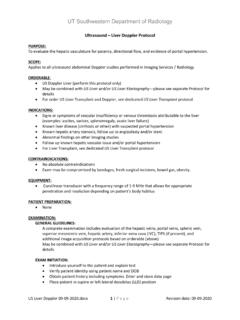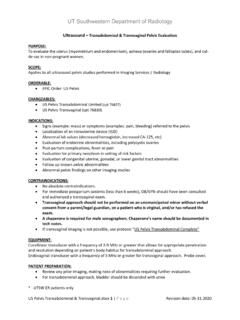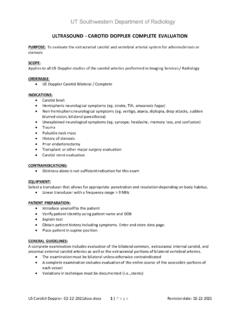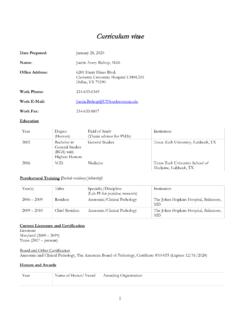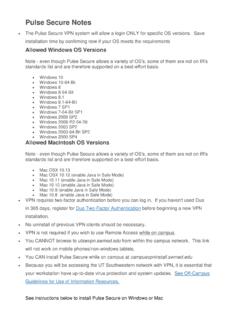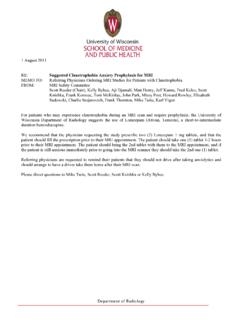Transcription of ULTRASOUND – TEMPORAL ARTERY DOPPLER
1 UT southwestern Department of radiology US TEMPORAL Arteries 1 | Page Revision date: 06-10-2020 ULTRASOUND TEMPORAL ARTERY DOPPLER PURPOSE: To evaluate TEMPORAL and axillary arteries for vasculitis (Giant Cell Arteritis). SCOPE: Applies to all US DOPPLER studies of the TEMPORAL arteries performed in Imaging Services / radiology BILLLING CODE: 93882 Duplex scan of extracranial arteries; unilateral or limited study INDICATIONS: Signs or symptoms of TEMPORAL arteritis (Headaches, vision loss, jaw pain, fever, fatigue and weakness). Abnormal lab values indicating vasculitis (eg. increased ESR, LFTs, Alk phos, IgG, complement) Prior history of vasculitis, polymyalgia rheumatic or other rheumatologic condition Abnormal findings on prior imaging CONTRAINDICATIONS: No absolute contraindications EQUIPMENT: Linear array transducer with frequency ranges greater than 9 MHz. PATIENT PREPARATION: None EXAMINATION: GENERAL GUIDELINES: A complete examination includes TEMPORAL arteries.
2 If necessary examination of axillary arteries. If carotid ARTERY evaluation is needed, a dedication US Carotid order may be required. EXAM INITIATION: Introduce yourself to the patient/family Verify patient identity using patient name and DOB Explain test Obtain patient history including symptoms. Enter and store data page Place patient in supine position. TECHNICAL CONSIDERATIONS: Review any prior imaging. One of the most important signs is the hypoechoic halo , a rim of uniform hypoechogenicity surrounding a long segment of the ARTERY . The halo may be best demonstrated with compressions. A halo thickness (from intimal to media) of mm is sensitive though not specific. A thickness of mm is highly predictive of arteritis. UT southwestern Department of radiology US TEMPORAL Arteries 2 | Page Revision date: 06-10-2020 Another important finding is areas of stenosis, which can be seen as areas of luminal narrowing with associated color DOPPLER aliasing.
3 Occlusion can also be seen. Affected vessels may be significantly tortuous. DOCUMENTATION: TEMPORAL ARTERIES o TRANSVERSE, both RIGHT and LEFT Without/with color DOPPLER (dual screen): Common superficial TEMPORAL arteries (prox; mid; distal) Frontal branch Parietal branch Cine loop compression, without/with color DOPPLER (dual screen) If hypoechoic halo identified, measure maximum thickness (one side of wall, outer to inner) Confirm halo and assess length of affected vessel in LONG If luminal narrowing/irregularity identified: Use color DOPPLER to show turbulent flow/aliasing Spectral DOPPLER waveform and peak velocity prior to, at, and beyond area of maximum stenosis. At least one Duplex spectral DOPPLER waveform of each TEMPORAL ARTERY Additional Duplex DOPPLER waveforms of any suspected occluded segment AXILLARY ARTERIES o Repeat above assessment for each axillary ARTERY if TEMPORAL arteries are found to be normal PROCESSING: Review examination images and data Confirm data in Imorgon (if applicable) Document relevant history and any study limitations.
4 REFERENCES: ULTRASOUND in the diagnosis and management of giant cell arteritis. Wolfgang A. Schmidt. Rheumatology, volume 57, Issue supplement. 2018. Pgs ii22-ii31, 44 Diagnostic performance of TEMPORAL ARTERY ULTRASOUND for the diagnosis of giant cell arteritis: a systematic review and meta-analysis of the literature, Rinagel M. et al. Autoimmunity Reviews 2019, 18(1), 56-61, UT southwestern Department of radiology US TEMPORAL Arteries 3 | Page Revision date: 06-10-2020 APPENDIX: Techniques in Ophthalmic Surgery, Chapter 108-Giant Cell ( TEMPORAL ) Arteritis Halo Sign (without/with compression) A halo thickness (from intimal to media) of mm is sensitive though not specific. A thickness of mm is highly predictive of arteritis. Luminal Irregularity UT southwestern Department of radiology US TEMPORAL Arteries 4 | Page Revision date: 06-10-2020 CHANGE HISTORY: STATUS NAME & TITLE DATE BRIEF SUMMARY Submission Allyson LaSalle, RDMS, RVT Monica Morgan, RDMS, RVT 05-27-2020 Submitted Approval David Fetzer, MD 05-30-2020 Approved Review Reviewed Revisions David Fetzer, MD 6-10-2020 Specified need for at least one Duplex spectral waveform for each side




